#kakinomoto no hitomaro
Text
II. Write a series of surrealist questions and answers, in the style of Paul Celan. Make a poem of the answers.
Land-calling up the eight corners
of earth under heaven.
Ships lost in island shade,
well knowing of herself, she sleeps
waves breaking on the rocks,
jeweled gift of the offing,
a ruined capital by an empty lake,
the scent of persimmons, ripening.
#napowrimo#paul celan#!!!#also#this is a#Kakinomoto no Hitomaro#appreciation poem#except where it is a#Takahashi no Mushimaro#poem#poetry#free form
4 notes
·
View notes
Text
IMAGEN Y PALABRA: BAMBUSAL DE ARASHIYAMA, Autoría, Aetheria
IMAGEN Y PALABRA: BAMBUSAL DE ARASHIYAMA, Autoría, Aetheria
@AetheriaTravels
Imagen y Palabra: Bambusal de Arashiyama
“En las montañas vacías
Las hojas de bambú
Susurran al viento.
Y pienso en ella,
que no está aquí”
“Sasa no ha wa
Miyama mo saya ni
Sayagedomo
Ware wo imo omo
Wakare kinureba”
Kakinomoto No Hitomaro
La imagen:
Este bosque de bambú se encuentra en la localidad de Arashiyama, al oeste de la ciudad japonesa de Kyoto. A ambos lados de un estrecho camino, los…
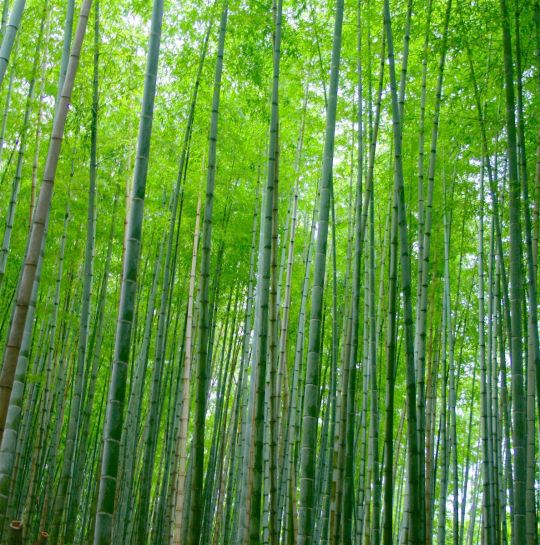
View On WordPress
#Aetheria#Bambusal de Arashiyama#Imagen y Palabra#Kakinomoto No Hitomaro#Las hojas de bambú susurran al viento#Poesía japonesa#Tanka#Viajar ver conocer
0 notes
Photo
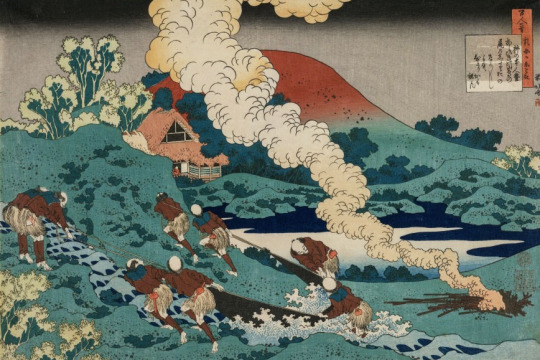
Katsushika Hokusai: Poem by Kakinomoto no Hitomaro, from the series One Hundred Poems by One Hundred Poets Explained by an Old Nurse, 1835-36
270 notes
·
View notes
Text

Title: No Kakinomoto Hitomaro
Artist: Katsushika Hokusai
Date: 1835
Style: Ukiyo-e
Style: Genre Painting
#art history#art#painting#artwork#museums#history#culture#vintage#ukiyo e#katsushika hokusai#curators#classicalcanvas
240 notes
·
View notes
Text
KAKINOMOTO NO HITOMARO
IL ROMBO DEL TUONO
Il rombo del tuono
nel cielo nuvoloso
forse pioverà.
E, quando accadrà resterai con me?
Il rombo del tuono
nel cielo nuvoloso
e anche se non piovesse
resterò con te.
(da Man'yōshū, Vol. 11, versi 2513 e 2514)
.
Il giardino delle parole è un breve film di animazione giapponese - o “anime” – realizzato da Makoto Shinkai nel 2013. A legare inizio e fine della storia – l’amicizia tra uno studente quindicenne e una donna ventisettenne che si incontrano in un giardino giapponese nei giorni di pioggia – c’è questo doppio tanka di Kakinomoto no Hitomaro, tratto dal Man'yōshū, ovvero la Raccolta delle diecimila foglie, antologia poetica compilata nella seconda metà dell’VIII secolo: una classica domanda e risposta in cui ci si dichiara amore eterno.
9 notes
·
View notes
Text
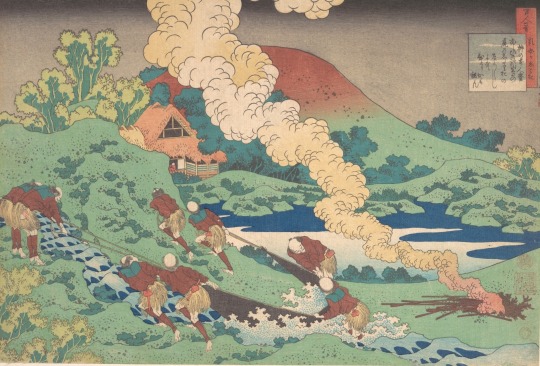
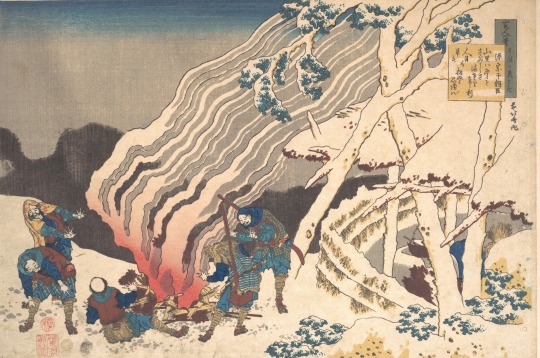
Katsushika Hokusai, Poem by Kakinomoto Hitomaro, from the series One Hundred Poems Explained by the Nurse (Hyakunin isshu uba ga etoki) 1839
Katsushika Hokusai, Poem by Minamoto no Muneyuki Ason, from the series One Hundred Poems Explained by the Nurse (Hyakunin isshu uba ga etoki) 1839
#katsushika hokusai#japanese prints#japanese art#japanese artist#asian art#landscape#japanese landscape#landscape aesthetic#aesthetic#beauty#nature#woodcut#woodblock print#art history#aesthetictumblr#tumblraesthetic#tumblrpic#tumblrpictures#tumblr art#tumblrstyle#artists on tumblr#modern art
12 notes
·
View notes
Text
百人一首, poem 3: 柿本人麿
Day 3 of this little challenge! Today's poem is by Kakinomoto no Hitomaro (柿本人麿), from the same text, same manuscript, same transcription conventions.
阿し飛起農やま鳥[とり]の尾[を]のし多里を能
な可な可し夜[よ]越ひとり可もね无
In modern standard kana, and split into the 5 lines of the waka:
あしびきの
やま鳥[とり]の尾[を]の
したりをの
ながながし夜[よ]を
ひとりかもねむ
A parse/analysis: (again, if anyone has *any* ideas as to how I could make these more accessible, I'm willing to do it. I have no idea how to alt text these.)

And a rough translation:
Must I sleep this night, ever so long as the dangling tail of that bird of the foot-pulling* mountains, alone?
*this is my best attempt at interpreting the 枕詞, 足引きの, based on its component parts, 足[あし] 'foot' and 引き 'pulling, tugging' (noun).
Again, I probably missed a lot of meaning, but that’s what practice and learning is for! This is a reminder that I’m no expert, I am but a lowly student, and this post is probably replete with errors despite my best efforts.
11 notes
·
View notes
Text
Nessuno potrà vedermi
né chiedermi qualcosa.
In sogno verrò da te stanotte;
non chiudere la porta al sogno.
Kakinomoto No Hitomaro
(660 ca. – 708 ca.)

9 notes
·
View notes
Text
anyway so i have had to do so much art history research for this tmnt fic b/c 1. the main character is an artist and i have to plausibly narrate about the artistic process and 2. there's a bunch of art history stuff about historical art techniques too
i mean there's a limit to how much research for accuracy i'm willing to do so i'm sure a lot of the details are wrong but w/e it's fine
some of the things i've turned up in this process:
'selected poems from kokin wakashu', with commentary.
from wikipedia:
The Kokin Wakashū (古今和歌集, "Collection of Japanese Poems of Ancient and Modern Times"), commonly abbreviated as Kokinshū (古今集), is an early anthology of the waka form of Japanese poetry, dating from the Heian period. An imperial anthology, it was conceived by Emperor Uda (r. 887–897) and published by order of his son Emperor Daigo (r. 897–930) in about 905. Its finished form dates to c. 920, though according to several historical accounts the last poem was added to the collection in 914.
The compilers of the anthology were four court poets, led by Ki no Tsurayuki and also including Ki no Tomonori (who died before its completion), Ōshikōchi no Mitsune, and Mibu no Tadamine.
[...]
The idea of including old as well as new poems was another important innovation, one which was widely adopted in later works, both in prose and verse. The poems of the Kokinshū were ordered temporally; the love poems, for instance, though written by many different poets across large spans of time, are ordered in such a way that the reader may understand them to depict the progression and fluctuations of a courtly love-affair. This association of one poem to the next marks this anthology as the ancestor of the renga and haikai traditions.
some of the commentary i particularly enjoyed:
よみ人しらず
題しらず
梅花たちよるばかりありしより人のとがむるかにぞしみぬる
ume no hana
tachiyoru bakari
arishi yori
hito no togamuru
ka ni zo shiminuru
Anonymous
Topic unknown
I lingered only a moment
beneath the apricot blossoms
And now I am
blamed for my
scented sleeves
In the context of its presumed source, the personal collection of Fujiwara no Kanesuke (d. 933), this is a love poem sent to a woman facetiously complaining that incense, redolent of apricot (or plum) blossoms, burnt to scent her robes, has infused his own, and that their relationship has thus been discovered by members of his household. That his complaint is facetious is attested by the evidence that he sent this poem to the woman (who knows better) by way of stating his intention not to be dissuaded. The editors of Kokinshu signal their intentions to reread this as a poem on "plum blossoms," not love, by placing it as an anonymous poem obliquely praising the seductive depth of the scent of the blossoms, in support of the poet's claim to have lingered only briefly.
and also
題しらず
ほのぼのと明石の浦の朝霧に島がくれ行く舟をしぞ思ふ
このうたは、ある人のいはく、柿本人麿が哥也
honobono to
akashi no ura no
asagiri ni
shimagakure yuku
fune wo shi zo omou
Anonymous
Topic unknown
Into the mist, glowing with dawn
across the Bay of Akashi
a boat carries my thoughts
into hiding
islands beyond
Some say that this poem was composed by Kakinomoto no Hitomaro.
Passage into Akashi Bay meant crossing the official gateway at Settsu from the Inner to the Outer Provinces, and the implied topic is border-crossing. This is one of the most often quoted and allegorically glossed poems of Kokinshu, and became one of a core of poems treated as having profoundly esoteric meanings within the "Secret Teachings of Kokinshu." Its reputation was enhanced, certainly, by the attribution to Hitomaro, venerated as one of the deities of the Way of Poetry. One Nijo School commentary suggests that the poem, generally taken as an allegory of the death of Prince Takechi, was deliberately placed by the editors in the book of travel rather than in that of mourning to free it from taboos attaching to poems of mourning.
just like, oh yeah the thing with history and with art is that they're enormously context-heavy; all of these poems were written in a certain artistic tradition, and the editors who rearranged and placed them in dialog with each other are synthesizing new interpretations of them. or just making categorization jokes.
the other thing i saw and really liked is this series of ukiyo-e prints called 'Tokaido 53 stations'. (as wikipedia says: a series of ukiyo-e woodcut prints created by Utagawa Hiroshige after his first travel along the Tōkaidō in 1832)
so the tokaido was one five 'great roads', the most important one (it linked edo and kyoto, so, yeah pretty important) and the artist traveled on it as part of some kind of ceremonial horse-gift delegation from the shogun to the emperor. that's a situation with whole other context that i don't know. anyway there were stations on the roar, you know, official inns and the like, and he ended up making a print for each station. (there's some debate over whether he actually saw each station since some of the prints are inaccurate or derivative of other illustrations & who can say to what degree that's just taking artistic liberty. one of the prints depicts a wintertime scene with snow and it's like, wait it doesn't actually snow at that location. maybe he just wanted to depict all four seasons and picked that station.)
i really liked the one of hakone and that got me to start looking where i could get a print of the thing. you can obviously go to like, art.com or walmart, or w/e and they're like oooh look you can get a premium giclée print of this!! a giclée print is just like a fancy inkjet printer, which i guess makes a certain amount of sense for prints of paintings, but these are woodblock prints. they're literally designed to be mass-produced! there's not really an 'original' of any of these, unless you consider 'first printing with original woodblocks' to be the 'originals', and all further printings to be 'reproductions'
so i went looking for anybody who was actually doing woodblock prints of these things in the modern day. that lead me to UNSODO: "UNSODO is the only publishing company in Japan that publishes woodblock prints." i don't know if that's really true or accurate but it's on their website.
they do have a bunch of HIROSHIGE prints on their store (which you might note is not an e-store; you have to email them your order information and they'll get back to you) they're ~13000 yen which is a vast difference from the $50 prints you can get at art.com but uhh these would be actual replications of the method of production, not just a laserjet given a big png of the print. you can also buy them via kyoto handcraft center for a like 90% markup for the convenience of a automated e-store, which seems like not a great deal imo.
anyway all of that definitely had me thinking about art and artistic production and replication and the ways art is both immortal and ephemeral. something something walter benjamin the work of art in its age of technological reproducability.
5 notes
·
View notes
Text
XX.
To the capital,
Hitomaro was called up,
but, in the leaving,
his wife flew up, and,
left him behind.
Prompt: write a poem that recounts a historical event. This “event” is recounted in Man’yōshū II:207-212. You can read Edwin Cranston’s very nice translation online here (p. 224 - 228).
1 note
·
View note
Text
Day 4 of Translating the Hyakunin Isshu: Yamabe no Akahito and Nara Period Poetry
Unveiling the Mesmerizing Verses of Yamabe no Akahito: Day 4 of the Hyakunin Isshu Translation Challenge
Hello folks. I hope you’re enjoying our journey thus far. As I’ve yet to receive any feedback I can only assume you’re madly in love with the project. 🙈😁
Ok. So where were we. Right, so we just left off from Day 3 which examined the work of Kakinomoto no Hitomaro (柿本人麻呂). Today we’re moving onto Yamabe no Akahito.
Yamabe no Akahito (山部 赤人 or 山邊 赤人) (fl. 724–736) was a poet of the Nara periodin…
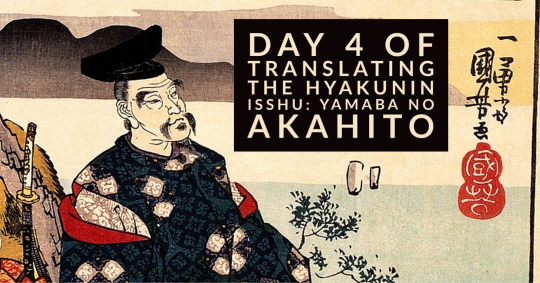
View On WordPress
#Ancient Japanese poems#Ancient literary treasures#Appreciating Japanese literary gems#Captivating imagery#Chōka and tanka#Classical poetry translation#Contemporary interpretations#Cultural Heritage#Cultural significance of poetry#Embracing poetic challenges#Exploring Nara period literature#Japanese literary traditions#Japanese poetic masters#Journey through Japanese history#Journey with Emperor Shōmu#Kami of poetry#Language and cultural exchange#Literary exploration#Man’yōshū anthology#Mesmerizing verses#Nara period poetry#Poetic expressions#Poetic symbolism#Thirty-six Poetry Immortals#Timeless beauty of poetry#Traditional art of waka#Translating ancient verses#Unveiling Yamabe no Akahito#Waka Nisei#Yamabe no Akahito
0 notes
Photo


( via / via )
The central part of the country is mostly weapon factories.
Disgusted at how the spirit of gaming has infiltrated every sphere, from news that can only see politics as team sports, to a class system increasingly devolving into winners punishing losers; from art subcultures that conflate status with achievement, to entertainment based solely upon tricking you into falling for false promises; truth is not just bent in the interest of the game, it is not even factored into the equation. And a place has already been prepared for those who've given up or been forced out of the game: this is all that keeps me playing, sheer mulishness. (Instead, i imagine i have found my own way of playing. This is to want to be misunderstood. ...Thus i count myself among the Seekers-of-Blame.)
A Clown and His Magic Frame.
(Years ago i posted this in the Tanka yahoogroup; i am reposting it here so as to have it all in one convenient place:)
a year or so ago i undertook to translate some of my favorite tanka into the artificial language Lojban. at the time i did this i noticed that the old Rexroth translations i used were not only not in form, but often not even five-lined; & so i thought when i posted them to the Lojban list, i would modify them into the same strictness as my translations. here is the result of that exercise, along with a few i added just the other day. i know on one level this sort of thing is as barbaric as when Dryden turned "Paradise Lost" into rhyming couplets. but, i'm not claiming it's an improvement. anyway...
1.
'As I watch the moon
shining on pain's myriad paths,
I know I am not
alone involved in Autumn.
--Oe no Chisato (Rexroth)
As I see the moon
tracing all the manifold
highways & footpaths
of pain, i know i am not
alone involved in Autumn.
(the literal Lojban runs: I observe the lunar illuminer of many harming roads, & intuit an autumn pattern of me & not-me.)
2.
'I go out of the darkness
onto a road of darkness
lit only by the far off
moon on the edge of the mountains.'
--Lady Izumi Shikibu (Rexroth)
[this is my all-time favorite tanka.]
Out of the darkness
onto a road of darkness
i go, illumined
only by the far-off moon
on the edge of the mountains.
(My going from the dark via dark ways, is illumined only by a small moon on the mountain slope.)
3.
'In the Autumn mountains
the colored leaves are falling.
If I could hold them back
I could still see her.'
--Kakinomoto no Hitomaro (Rexroth)
Here in the mountains
of Autumn the rufous leaves
have started to fall.
If i could only hold them
back--i could see her again.
(Autumn mountains. Falling are the leaves that have color. If i prevent it, i now see her.)
4.
'This is not the moon,
nor is this the spring,
of other springs,
and I alone
am still the same.'
--Ariwara no Narihira (Rexroth)
[this tanka has haunted me for twenty years, & i made many versions. after a while, the "moon" became a "song"; & my latest version owes as much to Earl Miner as to Rexroth:
'This is not that moon
And it cannot be this is the spring
Such as the spring I knew;
I am myself the single thing
Remaining as it ever was.' ]
This is not that spring,
nor even the selfsame song
so broken-hearted.
I myself am the one thing
staying as it ever was.
(It is not so, that here is the spring or the moon of me. Nevertheless, in it i myself am constant in pastness.)
5.
'The white chrysanthemum
is disguised by the first frost.
If I wanted to pick one
I could find it only by chance.'
--Oshikochi no Mitsune
White chrysanthemums,
lost amidst the handiwork
of this first snowfall:
if i tried to pick one i
could find it only by chance.
(The new-ice-weather hides the white ones from me. If i wanted to take, i only by luck could find one of the flowers.)
[unfortunately, Lojban lacks a precise word for "chrysanthemum"...]
Big things are happening in generative audio...
"The flourishing of a sword in a sword fight, especially when faced with several opponents at once, is called a MOULINETTE – literally a ‘little windmill’." --@HaggardHawks
Towers.
0 notes
Text
kakinomoto no hitomaro was the original “that was someone’s girlfriend”
0 notes
Text
Il rombo del tuono
nel cielo nuvoloso
forse pioverà.
E quando accadrà resterai con me?
Il rombo del tuono
nel cielo nuvoloso
e anche se non piovesse
resterò con te.
#anime#animazionegiapponese#ilgiardinodelleparole#KAKINOMOTO NO HITOMARO#ilrombodeltuono#frasi#quotes#pensieri
7 notes
·
View notes
Text
Le notti in cui mi illudi
di una tua venuta mancata,
sono divenute così numerose
che il pensiero di non aspettarti più
supera ormai l’attesa.
Kakinomoto No Hitomaro
10 notes
·
View notes
Text
No matter how much I mourn
I shall never see her again.
They tell me her spirit
May haunt Mount Hagai
Under the eagles’ wings.
I struggle over the ridges
And climb the summit.
I know all the time
That I shall never see her,
Not even so much as a faint quiver in the air.
All my longing, all my love
Will never make any difference.
—Kakinomoto no Hitomaro (trans. Kenneth Rexroth)
#me? crying over early heian poetry? it’s more likely than u think#Kakinomoto no Hitomaro#kenneth rexroth#japanese poetry#classical japanese literature#ellis reads#queue
15 notes
·
View notes